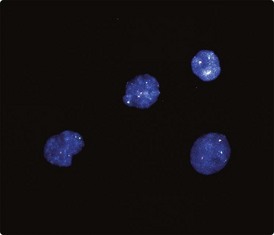50 FISH describes the hybridisation of specific DNA or RNA sequences in situ to cellular targets attached to microscope slides. The most popular probes are chromosome-specific DNA sequences which generate a brilliant signal in both metaphase and interphase nuclei. The technique is particularly useful in the demonstration of chromosomal monosomies or trisomies but chromosome translocations (Fig 50.1), deletions and amplification of specific genes can also be detected. The results of FISH may be further improved by image processing.
Molecular biology
Selected techniques used in the analysis of DNA
Fluorescence in situ hybridisation (FISH)
Molecular biology




